
In 1970, arson at CASBS partially destroyed two buildings – and the work of several fellows. One of them lost almost everything. Yet from the ashes he managed to write a book considered a classic. Here's the story.
“The chief casualty…was the conception of the center as a place of safety and peace.”
Members of today’s CASBS community may be tempted to utter words along those lines, in reference to the 2019-20 fellowship year here on the hill, intruded upon by the novel coronavirus pandemic.
As it turns out, the words were spoken by then-CASBS associate director Preston Cutler, a half-century ago.
April 24, 2020, is the 50th anniversary of a destructive fire at CASBS. But the fire, and its causes, also played the defining role in shaping a book considered a classic in social anthropology.
From the ashes, as they say…
Tragedy
It happened on April 24, 1970 – a Friday – at about 5am, so no staff or fellows were present. And it was no accident. That was immediately clear. It was arson. The arsonists actually attempted to set fires in four locations. The worst damage occurred to two banks of fellows’ offices, around here called studies – specifically, the wooden barrack-like buildings containing studies #1-6 and #17-20. Parts of them basically were gutted, demolished. Nearby studies were damaged by smoke and water. The Santa Clara County fire marshal determined that flammable liquid was ignited in each bank’s small telephone room (such rooms all over CASBS were converted into storage spaces years ago), which contained fast-burning acoustic tiles. The arsonists threw firebombs.
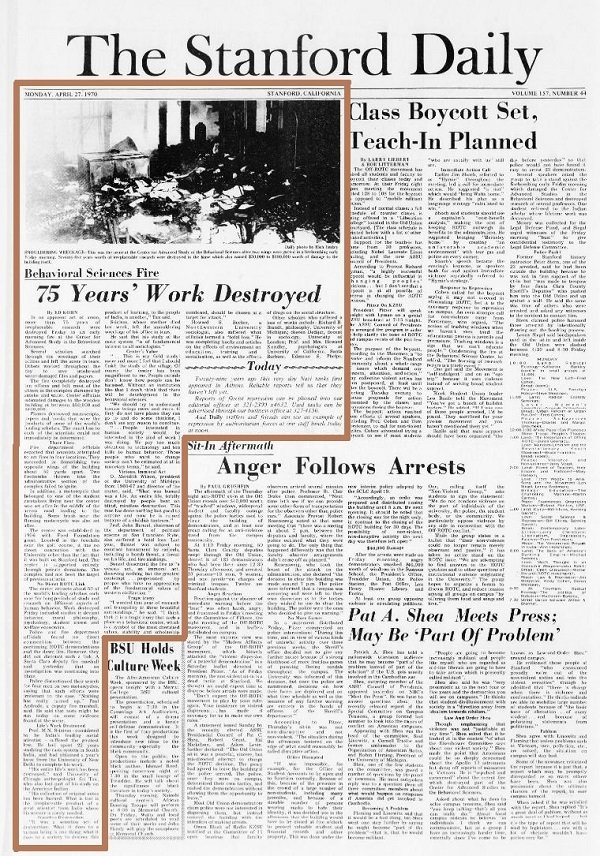
The damage could have been far worse – indeed potentially existential for the Center, then in its 16th year of operation. But some luck: two separate fires, one set in a service room of the main administration building (containing the front office, library, dining room, and main conference space), only smoldered on less flammable wallboard material before being extinguished by fire department responders.
Early reports estimated at least $40,000 (about $273,000 in today’s dollars) in damages to the Center’s structures and furnishings. In the weeks and months that followed, a more accurate accounting assessed damages at more than $100,000 ($682,000 today).
Who were the perpetrators, and what was their motive? Bottom line: we’ll likely never know with rock-solid certainty. The Santa Clara County Fire Marshal, John Baker, launched an investigation in coordination with police. According to reports, the only suspects were “several motorcyclists who had been in the area during the previous few days. They turned out to be student firemen who had been patrolling the Center and the campus to avert exactly the kind of incident that occurred.”[1]
By November 1970, six months later, authorities had few substantive leads and had not identified any other suspects. The case file remained open, but county officials admitted they were no longer actively working on it. Questioned at the time, Baker was not optimistic.
“Some you solve and some you don’t. In this kind of an arson attack it’s hard to come up with any suspects.”
Really? Heckuva job, Mr. Fire Marshal.
If student firemen patrolling on motorcycles sounds a bit off or even fishy, you’re likely not alone. On the other hand, remember this was 1970. The U.S. was neck-deep in the Vietnam war and there was, to say the least, a great deal of social and political unrest – sit-ins, occupations, protests, rallies, and violent conflicts – around the country in general and on college and university campuses in particular. Look no further than the U.S. bombing of Cambodia that started a month before the CASBS fire and the infamous shootings at Kent State University that occurred just 10 days after the fire. Stanford, just down the hill from CASBS, wasn’t a hotspot like Berkeley, across the San Francisco Bay. But it certainly wasn’t an exception either. Amelie O. Rorty, a 1969-70 CASBS fellow, wrote:
Though it had been a glorious year for us, it was a troubled year for the country. There were fires and riots…in the inner cities; there were student uprisings at Columbia and Berkeley…even at Stanford.[2]
Even at Stanford. John Markoff, the Pulitzer Prize-winning New York Times journalist, 2017-18 CASBS fellow, and current CASBS research affiliate, was a young man witnessing the upheaval himself as a Stanford Daily staff writer in the summer of 1970.
I have memories of boarded up windows in campus buildings that weren’t replaced for months or years. I also remember pitched battles with the Santa Clara tactical police force at night. Particularly a march to Hansen Labs, which was doing weapons development work. The demonstrators confronted the police on Palm Drive. Many were pushed back into Palo Alto but several hundred ran onto campus, playing a game of hide and seek from baton-swinging police for hours.[3]
So was CASBS a collateral victim of sorts, by one account suffering “at the hands of the radicals”?[4]
“I can hardly believe that any person educated to the purpose of the Center could be bent on its destruction,” said CASBS director Meredith Wilson at the time. Moreover, Wilson indicated that none of the Center’s funders were “actively involved in any war-related or major Defense Department work.”[5]
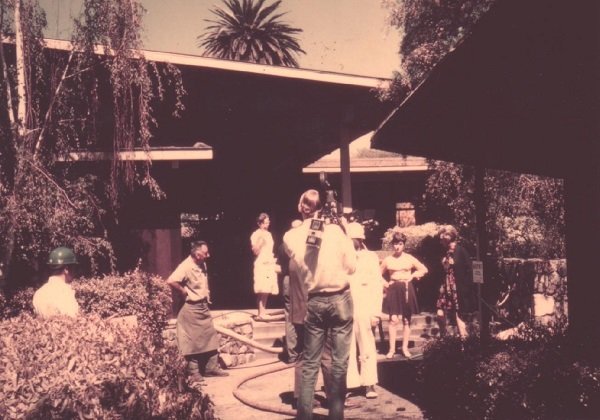
The perpetrators likely were not knowledgeable about the purpose of the Center,[6] however, and perhaps not aware that CASBS wasn’t even a part of the university.[7] As another 1969-70 CASBS fellow, Dwight Bolinger, wrote in The Harvard Crimson three weeks after the fire, “[W]e do not know whether the Center was a singular target, or a symbolic one, or merely a target of opportunity. What is clear is that the destruction at the Center took place in an atmosphere where physical violence, with cumulative effects, has increasingly become an accepted instrument of political and social action.”
But as a collective, the 1969-70 fellows, at least by one outside account, were not fully aligned in their thinking:
In the absence of evidence, a minor division occurred between fellows who assume that the fire was the work of radical Left militants and those who feel that blame can’t be allotted without proof. This division should not be exaggerated, but it did introduce a discordant note into what otherwise is a remarkably harmonious atmosphere.[8]
There had been an ongoing series of demonstrations against the Reserve Officers Training Corps (ROTC) program on the Stanford campus. And in fact, The New York Times mentioned the “separate incident” at CASBS practically as an afterthought in its April 25 reporting on a sheriff’s office raid of an occupied Stanford administration building, where a sit-in group of more than 100 people were protesting ROTC classes. Twenty-two were arrested, 12 of them Stanford students. Some were charged with trespassing.[9]
The raid occurred at about 1am on April 24, just four hours before the CASBS fire. Six months later, the default theory broadly associated the fire with the campus’s social and political turmoil.
A less likely, yet viable, theory portrayed 1969-70 CASBS fellow John Bunzel as a firebombing target. According to the Los Angeles Times, Bunzel, prior to arriving at CASBS, was “the frequent target of vandalism, harassment and anonymous threats…while teaching at San Francisco State. He came to the center to study the radical movement and student activism.” That’s interesting. Bunzel himself claimed “no reason to believe he was the object of the arsonists and had not been threatened since he joined the center,”[10]though early in 1969 he refused to support a student strike at S.F. State and publicly criticized the chair of S.F. State’s black studies department.[11] CASBS director Meredith Wilson quickly tried to throw water on that possible angle, expressing the view that an attack on Bunzel more likely would have been directed at Bunzel personally or his home residence. It’s not clear what CASBS fellows thought about Wilson’s reasoning.
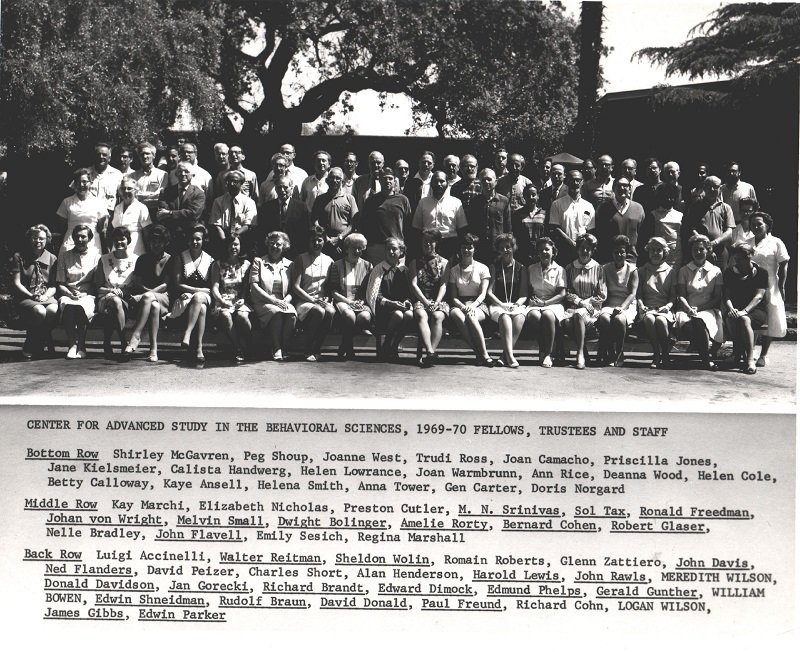
Bunzel’s study was among those mostly destroyed in the fire. He died in 2018.
He occupied – until April 24, 1970, that is – CASBS study #18.
* * *
In two paragraphs, the Center’s annual report for the year ending August 31, 1970, squarely but briskly addressed its “unique” 1969-70 academic year of operation. It thanked members of the CASBS community for helping with salvage efforts. Fellows and staff alike “weathered the emergency with great resiliency.” The Center also mailed letters to all former fellows (about 700 at that time), soliciting contributions for the establishment of a new “Phoenix Fund” to assist in rebuilding and providing new security measures. By August 31, 251 individuals contributed $16,932 ($115,413 in today’s dollars). Proceeds from the fund and a special $70,000 Ford Foundation grant ($477,140 today) were earmarked to install a sprinkler system throughout the Center, provide additional peripheral lighting on the grounds, purchase fireproof files for each study, and assist in the expense of maintaining night watchman service.[12]
Much of the cost of reconstruction was covered by insurance, it should be noted. And rebuilding occurred rather quickly so as to minimize disruption to the next class. In 1970-71 CASBS welcomed a full complement of 44 fellows.
Looking at the CASBS campus today, it’s nearly impossible for the untrained eye to discern that the two partially rebuilt study banks are not of the original 1954 vintage.
“There are notable differences,” said Phil Main, CASBS’s facilities manager since 2014. “For example, in each of the original study wings there is a thermostat in one study controlling heat for the entire wing, whereas in the building containing studies #17-20 there’s one thermostat per study for individual control. In the original wings, the heat is delivered through hot water flowing through copper pipes built into the concrete under the floor; in the 17-20 wing the delivery method is baseboard heaters. And, interestingly, the 17-20 wing features a trellis-type covering on the back side that extends for the length of the building. No other wing has that.”
* * *
The CASBS fire is noteworthy enough to register on a list of “famous farm fires,” dating back to 1888, occurring on Stanford University property.[13]
It has achieved that fame, or infamy, not only because the fire exacted a toll in physical infrastructure and in financial terms. In addition, it destroyed the scholarly work of several 1969-70 CASBS fellows. Impacted to one degree or another were sociologist Howard Becker (study #20), philosopher Richard Brandt (#3), sociologist Stevan Dedijer (#1), political scientist John Bunzel (#18), psychologist Howard Kendler (#2), economist and future Nobel Prize winner Edmund Phelps (#6), philosopher John Rawls[14] (#5), anthropologist M.N. Srinivas (#19), and anthropologist Sol Tax (#17). Though not a fellow, Kendler’s wife, psychologist Tracy Kendler, was using office space gutted by the fire.
The rhythms of everyday life on the CASBS hill were disrupted for a time, though a CASBS social event scheduled for the evening of April 24 went forward.[15] But just the loss, serious loss, of research material and writing! Of course this was decades before laptops and flash drives and iPads and cloud storage systems. From today’s vantage point the intellectual damage is hard to fathom or overestimate. One observer on the scene in the weeks after the fire, who interviewed several current and former fellows, described sentiment within the academic community in no uncertain terms:
The sharpness of the immediate reaction to the fire among behavioral scientists, particularly among the Center alumni, was revealing. Especially to those far removed from the scene, it appeared that the arsonists had not struck at an institution, but had deliberately destroyed the scholarly work of individuals. And news of the fire was received by some on the East Coast and abroad as a latter-day equivalent of the burning of the ancient library at Alexandria.[16]
This Man
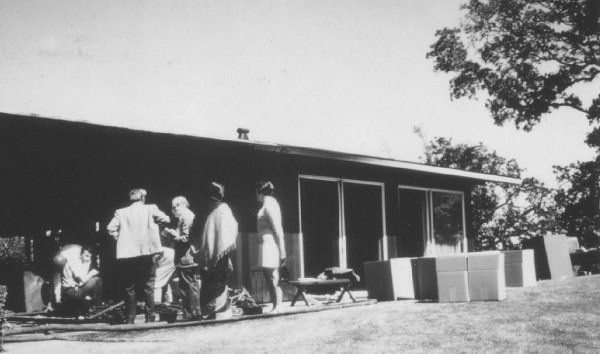
“They’ve burned a life – a scholar’s life,” said CASBS director Meredith Wilson. It certainly would have been apt if he meant that in the figurative sense of many scholars’ way of life. But he definitely meant it in terms of one specific scholar.
“What was burned was a life. An entire life, totally destroyed by people bent on blind, mindless destruction. This man had done nothing but good to anyone and now he is ruined because of a childish tantrum.”[17]
Among the fellows impacted, it was reported that Howard Becker suffered a “total loss” of material in his study. But “this man” Wilson referred to was M.N. Srinivas.
When he arrived at CASBS in January 1970[18]at the age of 53, mid-way through the fellowship year and on leave from his primary appointment at the University of Delhi, Mysore Srinivas already was considered India’s most distinguished social scientist. A sociologist by training, he earned his renown as a sociologist and social anthropologist who pioneered a participant-observer approach to ethnographic research, emulated by researchers who followed, that “sought to capture the fluid and dynamic essence of caste as a social institution” but with methodological implications that extended beyond that institution.[19] Fundamentally, he is credited with transforming his disciplines, at least within India, from “stodgy theories to first hand observation, in a way that was both humane and participatory.”[20]
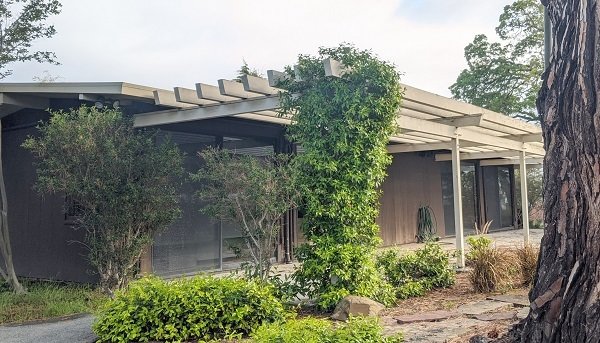
“He moved sociology from the so-called ‘book view’ toward the ‘field view,’” said Arvind Shah, himself a CASBS fellow in 1960-61. ''Earlier generations explained society from descriptions in the ancient texts. M.N. Srinivas encouraged his students to look at society in the raw, to get out into the villages, hospitals and trade unions.''[21]
In 1948 – the year after India gained independence – Srinivas began a journey researching social change in a multi-caste Indian village not far from where he grew up. He spent 11 months in his initial visit to that village, Rampura, and continued collecting data on periodic visits for the next 16 years. Along the way, there was a great deal of painstaking compiling, analyzing, and refining of field notes. His sabbatical at CASBS was reserved for writing-up his ethnography in book manuscript form, the culmination of two decades of labor.
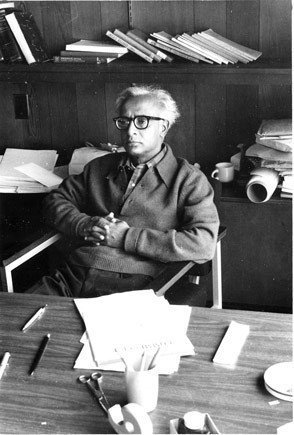
Srinivas’s CASBS fellowship had proceeded according to plan, uneventfully. The uneventful became disastrously eventful on April 24, 1970. The immediate assessments confirmed the worst. His study was practically reduced to ashes, with only steel pipes and burned redwood planks (that lined the interior walls of the study) plainly visible.
“His entire life’s work has been destroyed,” said fellow anthropologist Sol Tax, echoing Meredith Wilson. “His collection of notes has been burned. What is lost is the irreplaceable product of a great scientist from India where his science is sorely needed.”[22]
Until the fateful day, Srinivas occupied CASBS study #19. Immediately to the left of his study: that bank’s small telephone room that was firebombed. To its left, a bathroom. Then John Bunzel’s study, #18. Tax, who suffered minor damage to research material, was to the left of Bunzel in study #17 that year. Tax would play a pivotal role as events unfolded.
The Stanford Daily reported that, shortly after arriving on the scene, Srinivas “left the smoldering wreckage of his office in tears.”
Serious insult added to the injury. Srinivas’s mother had died five days earlier. His despair was overwhelming.[23]
But Srinivas was the singular “this man” not just because of the magnitude of research loss suffered. It was also because that research was of a kind and in a form that field sociologists and anthropologists in particular will understand.
In addition to books, charts, maps, photographs, and correspondences related to his ethnography, about 5,000 cards of hand-written, processed field notes were in the study. They recently had been sorted and stacked, reportedly in preparation for a duplication.[24]
And, by a “strange quirk of fate,” all three copies of his field notes, processed over 18 years, were in his study at the time of the fire.[25]
It’s been described as a gut-wrenching cautionary tale, an enduring case study in data disaster.
Triumph
For Srinivas, there was the initial shock. At first, contemplating his book manuscript’s prospects was, understandably, terrifying and paralyzing.
As Srinivas recounted six years later, fellow anthropologist Sol Tax, his nearby neighbor in study #17, paid him a visit at his residence just two days after the fire.
He told me that no social anthropologist, not even the most industrious, had ever published more than a small portion of his data. While the loss of my processed data was indeed a disaster, I should not forget that my colleagues valued my study not only because of the new material it provided on Indian rural life but because it was I who had done the field work. My mind, and my entire personality, had been involved in that experience, and what did I remember of it? I should try and do a book on Rampura based solely on my memory. Indeed, I should forget that I had made any field notes.[26]
It was an unorthodox path to consider, to say the least. And Srinivas did have a crude fallback option to think about.
The processed notes in his study, so many years in the making, were developed from source material – his raw field notes. Those were kept, thankfully, in Delhi. In a parallel effort and on its own initiative, the Ford Foundation in Delhi microfilmed the raw field notes, airmailed the film rolls to CASBS, and financed the residency, at CASBS, of a Srinivas research assistant who had accompanied him on some research trips to Rampura. CASBS, for its part, offered Srinivas the opportunity to remain for the 1970-71 academic year. Srinivas accepted for the first semester, and the University of Delhi assented to the extra leave time. A grant from the Wenner-Gren Foundation to CASBS supported Srinivas.
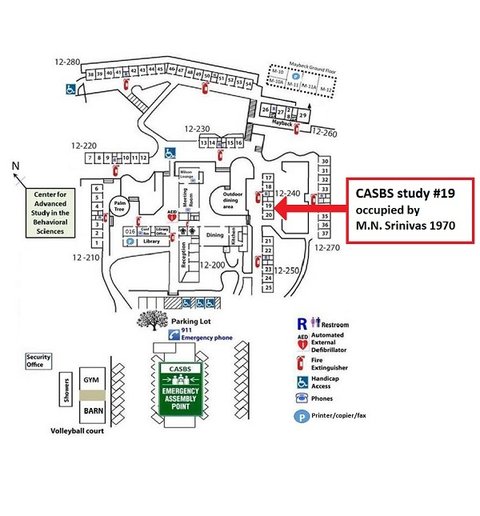
The raw field notes consisted of notes only from Srinivas’s first visit to Rampura. They did not contain corrections and addenda Srinivas recorded on cards on subsequent visits. Those were lost in the fire. The thought of going back to the raw data constituted what he said was a “psychological burden” on him.[27]He was at a crossroads of sorts.
Srinivas’s brain resisted at first. There were fits and starts as he started to compose new notes into distinct themes to get himself going. Soon after, he started using a dictaphone, which saved tremendous amounts of time. Between May and November, 1970, he had dictated the rough draft of a book. He had committed to a course of action.
Tax, himself a renowned anthropologist and a former president of the American Anthropological Association, had a swaying effect. Srinivas took the unorthodox path. He decided
to include in the book only those facts, incidents and impressions that I was able to remember. But that did not prevent me from checking against the field-diaries when I felt doubtful. Except in a very few cases, checking only confirmed what I had written.[28]
He made exceptions for the accuracy of numeric figures, which he “worked up from the original notes,” and a few other things.
And after that initial dictating flurry, the transcribed draft went through various iterations and revisions for more than three years.
The final result, poignantly titled, was The Remembered Village, published by the University of California Press in 1976. It captures, in great detail, the complexities of inter- and intra-caste relations in the Rampura community. The book is known for its humane and humanistic tone; its holistic, lucid, and illuminating descriptions of relations; and its insights into the nature of ethnographic research.
A first edition copy of the book resides in the Center’s Ralph W. Tyler Collection. UC Press released a paperback version in 1980. Oxford University Press issued a second edition in 2012.
Kamala Visweswaran, a UC San Diego anthropologist and 2014-15 CASBS fellow, read The Remembered Village as a UC Berkeley student for a course taught by Gerald Berreman (a 1976-77 CASBS fellow). She described Srinivas as “scrupulously methodological” and interpreted the book’s unorthodox approach as a triumph.
The result was an innovation, a ‘memory ethnography’ of uncommon plain-spokenness and social complexity; of dry humor and nuanced social analysis. The fire at the Center had proved a boon in disguise.[29]
In his scholarly career Srinivas was the author or co-author of 15 books, some of them acclaimed, but The Remembered Village is the one for which he is remembered most, and his own story in its creation is a part of sociological and anthropological legend.
That Srinivas produced any book at all is remarkable. The Remembered Village was not just any book. It was considered a landmark achievement at the time,[30]and still is recognized as a classic today. Don Brenneis, a 2007-08 CASBS fellow and Distinguished Professor Emeritus of Anthropology at UC Santa Cruz with extensive field experience and expertise in South Asia, puts it this way:
The Remembered Village is sui generis, a still quite significant contribution to anthropological and South Asian scholarship and an engaging, eloquent, and path breaking work. Given how painstakingly yet imaginatively Srinivas shaped his account and his memory of his field materials, the book represented a very distinctive and innovative approach to ethnographic writing and representation. In a singular way it anticipated the rise of more experimental and epistemologically challenging ways of pursuing our work as anthropologists. Srinivas's book embodies striking resilience in thought-provoking and affecting ways. It also, in ways that he may not have anticipated, opened new ways of engaging, writing, and remembering those communities at the heart of our research.[31]
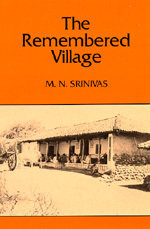
Tax, who implored Srinivas to move forward in much the way that he did, wrote the foreward to the book. In the foreward, Tax describes anthropology’s difficulty in achieving the “high art” of an ethnography that truly, holistically reflects the cultures and peoples it describes, where the ethnographer completely submerges professional interests, if not personality, in service of the culture he or she has come to know. The process itself “fogs the mind” – one can descend into the vacuum of a false ‘objectivity’ that is “polluted with all of the intrusions of the unconscious.”
All that said (and more), Tax declared that The Remembered Village was among the five percent or so of ethnographies that “shares the glory of being holistic.”
[As] so often in human affairs and in scholarly and scientific history, an accident opens the path to a solution. Professor Srinivas’s monograph, based on the human mind’s extraordinary capacity to bring forth significant details of the past, is a major ethnographic portrait woven from the warp of immersion in the sea of original data and the weft of purposeful seeking after a description of a village in its own terms. Its success will suggest not that we should all destroy our field notes, but that we need not let them destroy our art![32]
For his part, Srinivas, in the book’s preface, acknowledged the hope and courage Sol Tax instilled in him during a very dark hour, simply stating:
This book is the result of his advice and encouragement.
So simple, but quite a statement; tantamount to a dedication. Yet the book is not dedicated to Tax. It likely would have been bad form for Srinivas to reserve the book’s dedication page to the scholar, friend, and fellow CASBS fellow who he asked to write the book’s foreward.
One could make an excellent case that Srinivas might have dedicated the book to the people of Rampura village, with whom he spent so much time stretching back to 1948. But the rest of the book itself, its entire text, quite literally was dedicated to Rampura.
After all he had been through, Srinivas had a different idea for the dedication page of The Remembered Village.
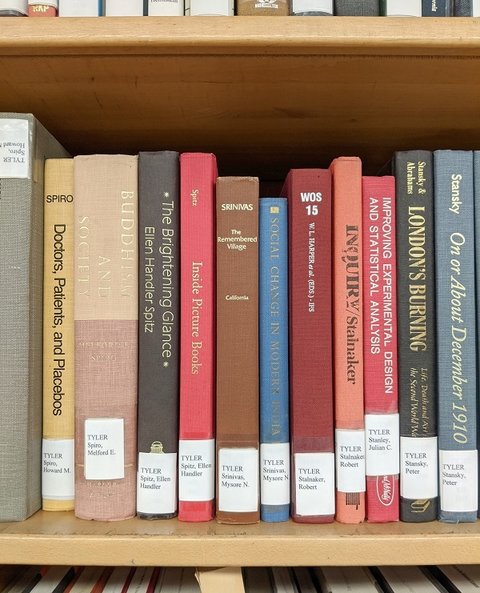
There’s a fitting logic to it. The book it was intended to be was born in Rampura, but then it died 22 years later, at CASBS. The intended book would have presented the author’s exhaustive field work in a completely different way and, assuredly, with a completely different title.
The book it became was born – or reborn – shortly after that death. And again, CASBS was the place. There was a very specific reason for both the death and rebirth. The dedication page:
"Had not all the copies of my processed notes been burnt in the fire on 24 April 1970 at the Center for Advanced Study in the Behavioral Sciences, Stanford, I would not have thought of writing a book based entirely on my memory of my field-experiences. I wish therefore to acknowledge the part played by the arsonists in the birth of this book."
Graphic by Ravi Shivanna
Former CASBS fellow Jules Naudet first became aware of CASBS through the work of M.N. Srinivas and the extraordinary events of 1970. Watch Naudet discuss it here.
Footnotes
[1] Don Tollefson, “No Suspects, Leads Found in Behavioral Center Fire,” The Stanford Daily, Vol.158, Issue 31, 10 November 1970. For earlier reporting, see Ed Kohn, “Behavioral Sciences Fire,” The Stanford Daily, Vol.157, Issue 44, 27 April 1970, p.1
[2] Amelie O. Rorty, “CASBS: Spring, 1970,” a reflection, on CASBS’s 60th anniversary website, 2015, accessed here. Melvin Small, another 1969-70 CASBS fellow, later wrote that “Nationwide, colleges dealt with civil and not so civil protests over black and women’s studies, the war, classified research, and student rights. These issues naturally reached our idyllic community on the hill. Melvin Small, “Firebombing at CASBS,” a reflection, on CASBS’s 60th anniversary website, 2015, accessed here.
[3] Email communication with CASBS communications office, 20 April 2020. Jefferson Cowie, a 2019-20 CASBS fellow and social historian of American politics and culture, provides added context:
“The first year of the 1970s saw the student left’s political hopes descend into increasingly violent desperation. Unable to stop the war in Vietnam and impatient with the slow pace of social change, disillusioned activists turned to militancy in an effort to change a system that, in their eyes, had proved unalterable through traditional political means. For many, protest had run its course.
Students killed by national guardsmen at Kent State and Jackson State, the burning of the Bank of America in a student uprising at UCSB, conflicts in the aftermath of the People’s Park in Berkeley, the Weather Underground’s turn to bombings, the CASBS firebombing, all suggest the end of the optimism of the 1960 and the rise of a more cynical age.” Email with CASBS communications office, 20 April 2020.
[4] Lyman, Richard W. (2009) Stanford in Turmoil: Campus Unrest 1966-72. Stanford University Press; “At the Hands of the Radicals’” Stanford Magazine, January/February 2009.
Further afield, Republican U.S. Senator Charles Percy of Illinois, named Stanford’s 1970 commencement speaker, said the fire destruction was “the direct result of a senseless, premeditated act by malicious, irrational people. It is despicable and deplorable.” “Sen. Percy and the Arsonists,” Chicago Tribune, 2 May 1970, p.S10.
[5] The Stanford Daily, 10 November 1970. Wilson to the Los Angeles Times: “The people who struck…in an act of childish tantrum, couldn’t have had the slightest knowledge of what goes on here…it suggests complete stupidity.” Philip Hager, “Valuable Works of 10 Scholars Destroyed in Palo Alto Blaze,” Los Angeles Times, 25 April 1970, p.1.
[6] Anti-establishment “radicals” who knew better would not have bothered with CASBS. For example, one of the editors of the Berkeley Barb, an underground counterculture newspaper that covered the anti-war movement, wrote in part: “SPEAKING OF BOMBING – And incompetent bombers – that asshole who burned the Center for Advanced Study in the Behavioral Sciences down at Stanford Friday did a [decent] job, technically speaking…but his choice of targets sucks. He wiped out years of research by several sociologists, who are the Academic Good Guys most of the time…” Berkeley Barb, Vol. 10, Issue 17 (246), May 1-7, 1970, p.16. There’s much more colorful and forceful language in the editorial, but the CASBS website is family-friendly…
[7] CASBS was an independent research center, established in the early 1950s by the Ford Foundation, leasing Stanford land. The Center did not merge with Stanford University until 2008. Read about the pre-history and early history of CASBS here. For the story of how and why CASBS was built where it is, read here.
[8] John Walsh, “Behavioral Sciences: The View at the Center for Advanced Study,” Science Vol.169, 14 August 1970, pp.654-655.
[9] Wallace Turner, “22 Seized Fleeing Stanford Protest,” The New York Times, 25 April 1970, p.34.
[10] Los Angeles Times, 25 April 1970.
[11] Bunzel’s politics appeared to be center-right. See his Hoover Institution bio here.
[12] Center for Advanced Study in the Behavioral Sciences, Annual Report: Year Ending August 31, 1970, p.4. CASBS files.
[13] “Famous Farm Fires,” Stanford Magazine, 2 February 2012. “The farm” is an affectionate nickname that refers to the days “when horses rather than students roamed in what previously was the farm of university founders Leland and Jane Stanford.”
[14] We must pause here to boast that, yes, Rawls completed his seminal book, A Theory of Justice, as a CASBS fellow during the 1969-70 year. According to 1969-70 fellow Amelie Rorty, at about noon on April 24, “…Jack [Rawls] went into his own study to see how badly it had been damaged. The wall had been somewhat seared, but the manuscript for *A Theory of Justice* lay intact on his desk where he had left it the previous afternoon.” Amelie O. Rorty, “CASBS: Spring, 1970,” a reflection on CASBS’s 60th anniversary website, 2015, accessed here. Rorty was in study #45 during 1969-70.
[15] CASBS audio interview of 1969-70 fellow James Short Jr. in 2005, on the occasion of the Center’s 50th anniversary, on CASBS’s 60th anniversary website, 2015, accessed here. In the interview, Short reads text written by another 1969-70 fellow, Luvern Cunningham, indicating that for most fellows the fire served as a “stimulus for a remarkable rededication to the important problems of institutional life.” Short was in study #53; Cunningham in #10.
Three decades later, fellow Amelie O. Rorty wrote that “Some fellows refused to continue to work in their studies until the Center provided massive security; other Fellows said they would not work in a place that had become a fortress.” Amelie O. Rorty, “CASBS: Spring, 1970,” a reflection on CASBS’s 60th anniversary website, 2015, accessed here.
[16] John Walsh, “…and a Fourth,” Change: The Magazine of Higher Learning, Vol.2 Issue 6, November-December 1970, p.59.
[17] The Stanford Daily, 27 April 1970. Quote in previous paragraph: Los Angeles Times, 25 April 1970.
[18] In fact, this was Srinivas’s second time around. He previously was a CASBS fellow during the 1964-65 academic year. He occupied study #50 that year.
[19] See Wikipedia entry for M.N. Srinivas here.
[20] Napur Basu, “MN Srinivas: Scholar of Indian Village Life and the Caste System,” The Guardian, 22 December 1999.
[21] Barry Bearak, “M.N. Srinivas Is Dead at 83; Studied India’s Caste System,” The New York Times, 3 December 1999, p.C23.
[22] The Stanford Daily, 27 April 1970.
[23] Roger Sanjek, “Fire, Loss, and the Sorcerer’s Apprentice,” in Sanjek, Roger, ed. (1990). Fieldnotes: The Makings of Anthropology, Cornell University Press, pp.35-36.
[24] John Walsh, “After Fire, Scholar Faces Painful Reprocessing of Data,” Science Vol.169, 14 August 1970, p.657.
[25] With little time to waste, after the smoke cleared a heroic retrieval and salvage effort launched in earnest. Within a few months a more fine-grain picture emerged. More than 1,000 cards of field notes were wholly gone forever. Thanks to a Stanford-based document preservationist (assisted by CASBS staff and some fellows’ spouses acting in a volunteer capacity) who chose to remain anonymous and a labor- and time-intensive process, portions and bits of burnt cards were inserted individually in plastic folders and variously subjected to cold temperatures (to prevent mold), high humidity (to prevent disintegration) and, eventually, ultraviolet light (to try to read and photograph). Srinivas acknowledges this effort, but only indicates that any usable recovered notes merely “supplemented” his own “recollection of things and events.” Walsh, in Science, p. 657; Srinivas, 1976, pp.xiii-xiv.
[26] Srinivas, M.N. (1976), The Remembered Village. University of California Press, p.xiv. Reflecting decades later, one of Srinivas’s former students and colleagues, B.S. Baviskar, told The New York Times that friends persuaded him to finish the work from memory. ''We told him, 'The book is in your head and not just in the notes.’ In the end, that made the book more readable. It had no scholarly references and tables. It was something that came more from the heart.'' The New York Times, 3 December 1999.
[27] Walsh, in Science, p.657.
[28] Srinivas, 1976, p.xv.
[29] Kamala Visweswaran, “Fire on the Hill: The Making of a Modern Classic,” a reflection, on CASBS’s 60th anniversary website, 2015, accessed here.
[30] For example, T. Scarlett Epstein, “The Remembered Village: A Modern Classic,” Contributions to Indian Sociology, Vol.12, No.1, 1978, pp.67-74.
Few scholarly books, of course, are without their critics. The Remembered Village is no exception, but the debates are beyond the scope and concerns of the present article. See the essays in Contributions to Indian Sociology, including a Srinivas reply to his critics. Madan, T.N. “A Review Symposium on M.N. Srinivas’s The Remembered Village,” Contributions to Indian Sociology, Vol 12, pp.1-152.
Kamala Visweswaran (2015) briefly sketches continuing debates that extended at least into the early 2000s – “proof enough,” she wrote, “that a classic never remains unread.”
[31] Email to CASBS communications office, 21 April 2020.
[32] Srinivas, 1976, pp.ix-xi.
